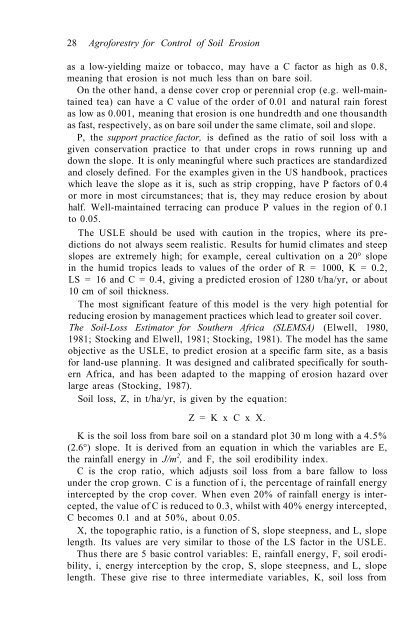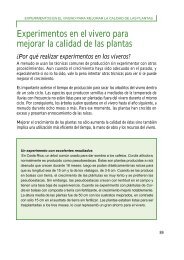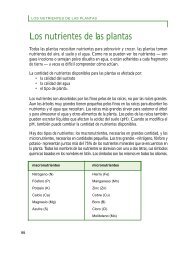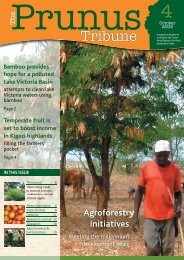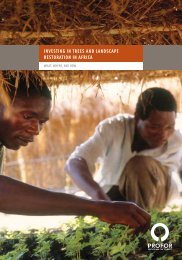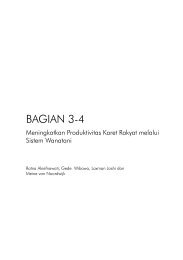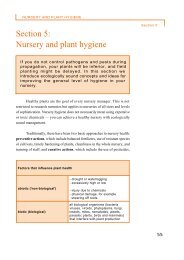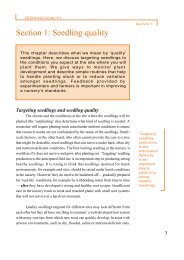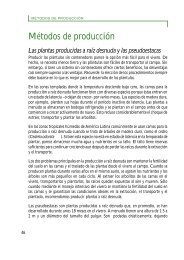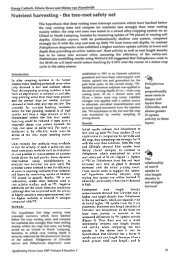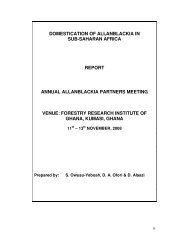Agroforestry for Soil Conservation - World Agroforestry Centre
Agroforestry for Soil Conservation - World Agroforestry Centre
Agroforestry for Soil Conservation - World Agroforestry Centre
Create successful ePaper yourself
Turn your PDF publications into a flip-book with our unique Google optimized e-Paper software.
28 <strong>Agro<strong>for</strong>estry</strong> <strong>for</strong> Control of <strong>Soil</strong> Erosion<br />
as a low-yielding maize or tobacco, may have a C factor as high as 0.8,<br />
meaning that erosion is not much less than on bare soil.<br />
On the other hand, a dense cover crop or perennial crop (e.g. well-maintained<br />
tea) can have a C value of the order of 0.01 and natural rain <strong>for</strong>est<br />
as low as 0.001, meaning that erosion is one hundredth and one thousandth<br />
as fast, respectively, as on bare soil under the same climate, soil and slope.<br />
P, the support practice factor, is defined as the ratio of soil loss with a<br />
given conservation practice to that under crops in rows running up and<br />
down the slope. It is only meaningful where such practices are standardized<br />
and closely defined. For the examples given in the US handbook, practices<br />
which leave the slope as it is, such as strip cropping, have P factors of 0.4<br />
or more in most circumstances; that is, they may reduce erosion by about<br />
half. Well-maintained terracing can produce P values in the region of 0.1<br />
to 0.05.<br />
The USLE should be used with caution in the tropics, where its predictions<br />
do not always seem realistic. Results <strong>for</strong> humid climates and steep<br />
slopes are extremely high; <strong>for</strong> example, cereal cultivation on a 20° slope<br />
in the humid tropics leads to values of the order of R = 1000, K = 0.2,<br />
LS = 16 and C = 0.4, giving a predicted erosion of 1280 t/ha/yr, or about<br />
10 cm of soil thickness.<br />
The most significant feature of this model is the very high potential <strong>for</strong><br />
reducing erosion by management practices which lead to greater soil cover.<br />
The <strong>Soil</strong>-Loss Estimator <strong>for</strong> Southern Africa (SLEMSA) (Elwell, 1980,<br />
1981; Stocking and Elwell, 1981; Stocking, 1981). The model has the same<br />
objective as the USLE, to predict erosion at a specific farm site, as a basis<br />
<strong>for</strong> land-use planning. It was designed and calibrated specifically <strong>for</strong> southern<br />
Africa, and has been adapted to the mapping of erosion hazard over<br />
large areas (Stocking, 1987).<br />
<strong>Soil</strong> loss, Z, in t/ha/yr, is given by the equation:<br />
Z = K x C x X.<br />
K is the soil loss from bare soil on a standard plot 30 m long with a 4.5%<br />
(2.6°) slope. It is derived from an equation in which the variables are E,<br />
the rainfall energy in J/m 2 , and F, the soil erodibility index.<br />
C is the crop ratio, which adjusts soil loss from a bare fallow to loss<br />
under the crop grown. C is a function of i, the percentage of rainfall energy<br />
intercepted by the crop cover. When even 20% of rainfall energy is intercepted,<br />
the value of C is reduced to 0.3, whilst with 40% energy intercepted,<br />
C becomes 0.1 and at 50%, about 0.05.<br />
X, the topographic ratio, is a function of S, slope steepness, and L, slope<br />
length. Its values are very similar to those of the LS factor in the USLE.<br />
Thus there are 5 basic control variables: E, rainfall energy, F, soil erodibility,<br />
i, energy interception by the crop, S, slope steepness, and L, slope<br />
length. These give rise to three intermediate variables, K, soil loss from


